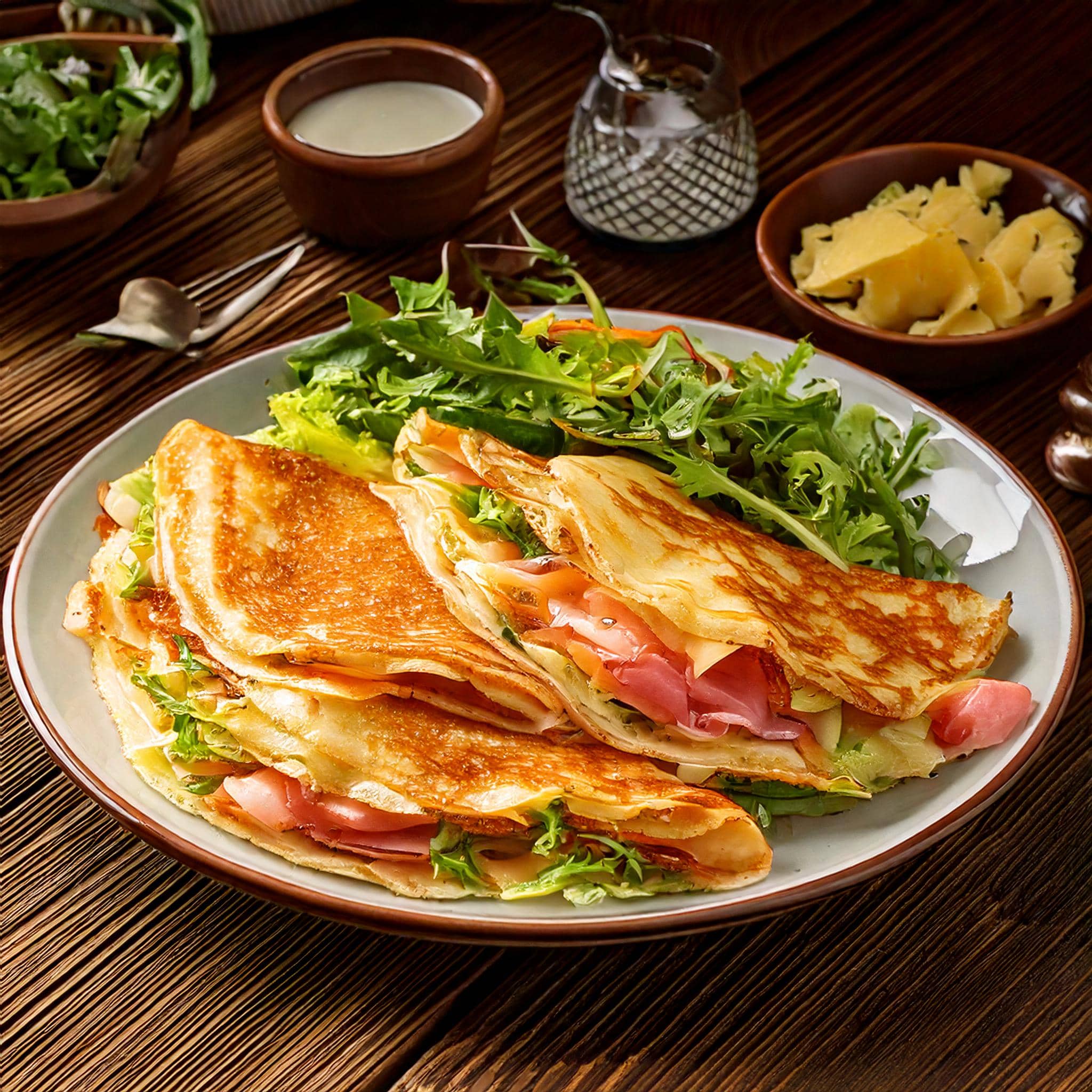Making crêpes might seem simple, but mastering them requires knowing specific secrets. So, what is the secret of a good crêpe? It’s a blend of the right ingredients, precise techniques, and creative fillings. In this guide, we’ll explore these essential elements to help you make perfect crêpes every time.
Table of contents
Key Ingredients That Reveal What Is the Secret of a Good Crêpe
The first step to understanding what is the secret of a good crêpe is using the best ingredients. The perfect crêpe batter depends on high-quality flour, fresh eggs, and the right amount of milk and butter.
Choosing the Right Flour for Perfect Crêpes
Flour is the foundation of the batter and plays a key role in what is the secret of a good crêpe. Use all-purpose or buckwheat flour for savory crêpes and sift it for a smooth texture.
- Type of Flour: Use all-purpose flour for basic crêpes. For extra lightness, consider using cake flour or a mix of all-purpose and buckwheat flour for savory crêpes.
- Sifting: Sift the flour before adding it to the batter. This prevents lumps and ensures a smoother texture.
- Measuring Correctly: Use precise measurements for consistent results. Overloading the flour can result in thick, chewy crêpes.
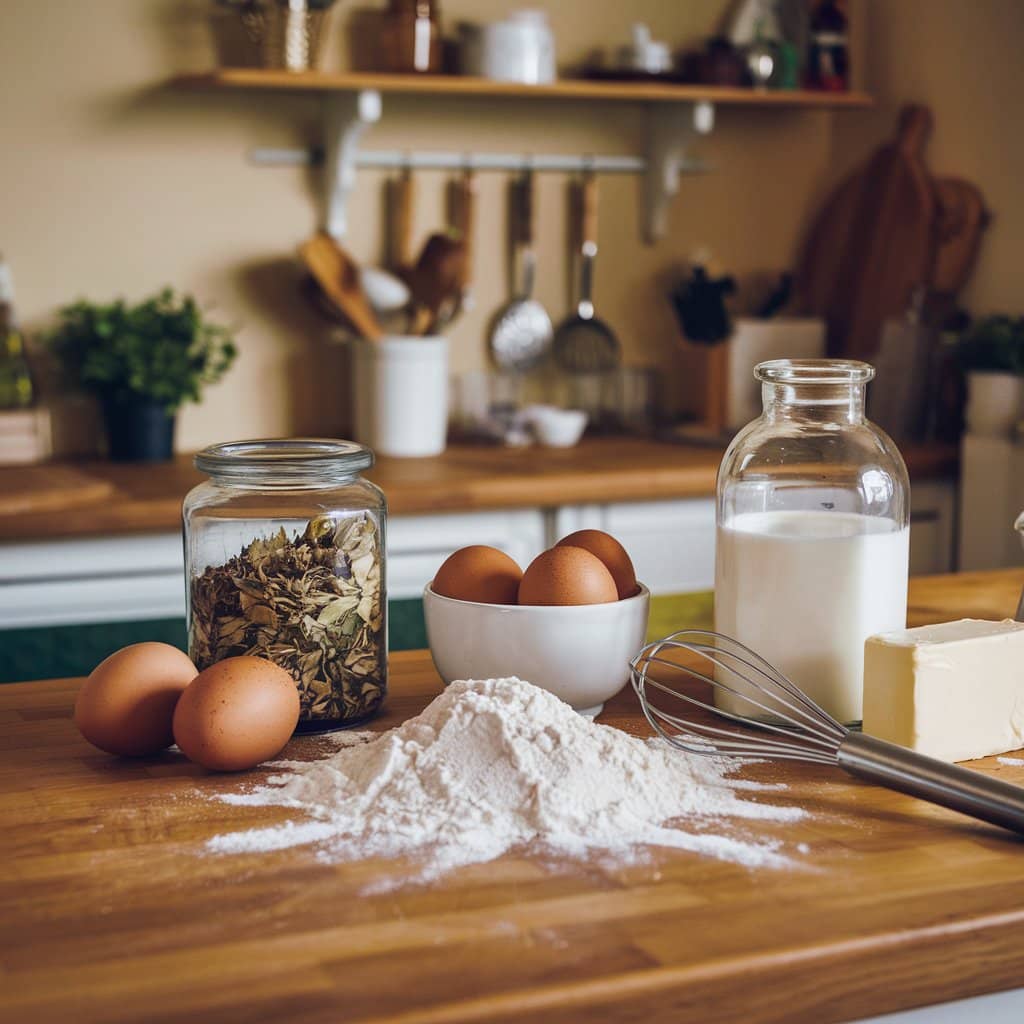
Fresh Eggs – The Secret to Perfect Crêpe Batter
Fresh eggs add richness and help bind the batter, revealing what is the secret of a good crêpe. Use large eggs for the best consistency.
- Egg Size: Use large, fresh eggs. They help bind the ingredients and provide elasticity.
- How Many: The standard ratio is two to three eggs per cup of flour, ensuring the crêpes hold together without becoming rubbery.
Milk for a Smooth Texture
Whole milk and melted butter create a smooth, rich batter. This is what is the secret of a good crêpe when aiming for a light, flavorful texture.
- Type of Milk: Whole milk is recommended for richness, though low-fat milk can be used for a lighter option.
- Consistency Tip: For ultra-light crêpes, replace a portion of the milk with water or sparkling water to introduce airiness.
Butter for Flavor and Moisture
Butter enhances flavor and prevents sticking.
- Melting the Butter: Use melted, unsalted butter to control salt levels and avoid overpowering the crêpe’s natural taste.
- Adding It Correctly: Mix the melted butter into the batter last to ensure even distribution.
A Pinch of Salt and Sugar
- Salt: A small pinch of salt balances the flavors, even in sweet crêpes.
- Sugar: Add sugar only if making sweet crêpes. Vanilla extract or a touch of citrus zest can enhance the flavor even more.
With these ingredients chosen and prepared properly, you’ll be one step closer to making the perfect crêpes.
Mastering the Crêpe Batter
What is the secret of a good crêpe when making batter? It’s all about getting the right consistency through proper mixing and resting the batter.
Correct Ingredient Ratios
The classic crêpe batter ratio is simple:
- 1 cup of flour
- 2 large eggs
- 1 1/2 cups of milk
- 2 tablespoons of melted butter
- A pinch of salt and sugar (for sweet crêpes)
Adjust the proportions slightly if you want thinner or thicker crêpes.
Mixing the Batter Properly
To uncover what is the secret of a good crêpe, mix the ingredients gradually, whisking to prevent lumps. Consider using a blender for the smoothest batter.
- Start with Dry Ingredients: Combine flour, salt, and sugar (if using) in a mixing bowl.
- Add Eggs and Milk Gradually: Make a well in the flour and add eggs. Slowly pour in the milk while whisking to avoid lumps.
- Whisk Until Smooth: Use a hand whisk or blender to ensure the batter is lump-free. Be gentle but thorough.
- Incorporate Butter: Stir in the melted butter for extra richness.
Resting the Batter
Resting the batter for 30 minutes or longer is what is the secret of a good crêpe for ensuring tenderness and elasticity.
- Why Rest? It allows the flour to absorb the liquid fully, reducing bubbles and making the batter smoother.
- How Long? Rest the batter for at least 30 minutes at room temperature or up to 24 hours in the refrigerator.
- Consistency Check: After resting, the batter should be slightly thinner than pancake batter. If it’s too thick, add a splash of milk or water.
Common Batter Mistakes to Avoid
- Overmixing: Over-whisking activates gluten in the flour, making crêpes tough. Mix just until smooth.
- Skipping Resting Time: If you’re in a hurry, let the batter rest for at least 10-15 minutes.
- Wrong Consistency: Avoid batter that’s too thick or too runny. Adjust with liquid or flour as needed.
By following these tips, your crêpe batter will be smooth, flavorful, and ready to create mouthwatering crêpes.
Cooking Techniques for Perfect Crêpes
What is the secret of a good crêpe when cooking? It’s about using the right pan, heat, and timing.
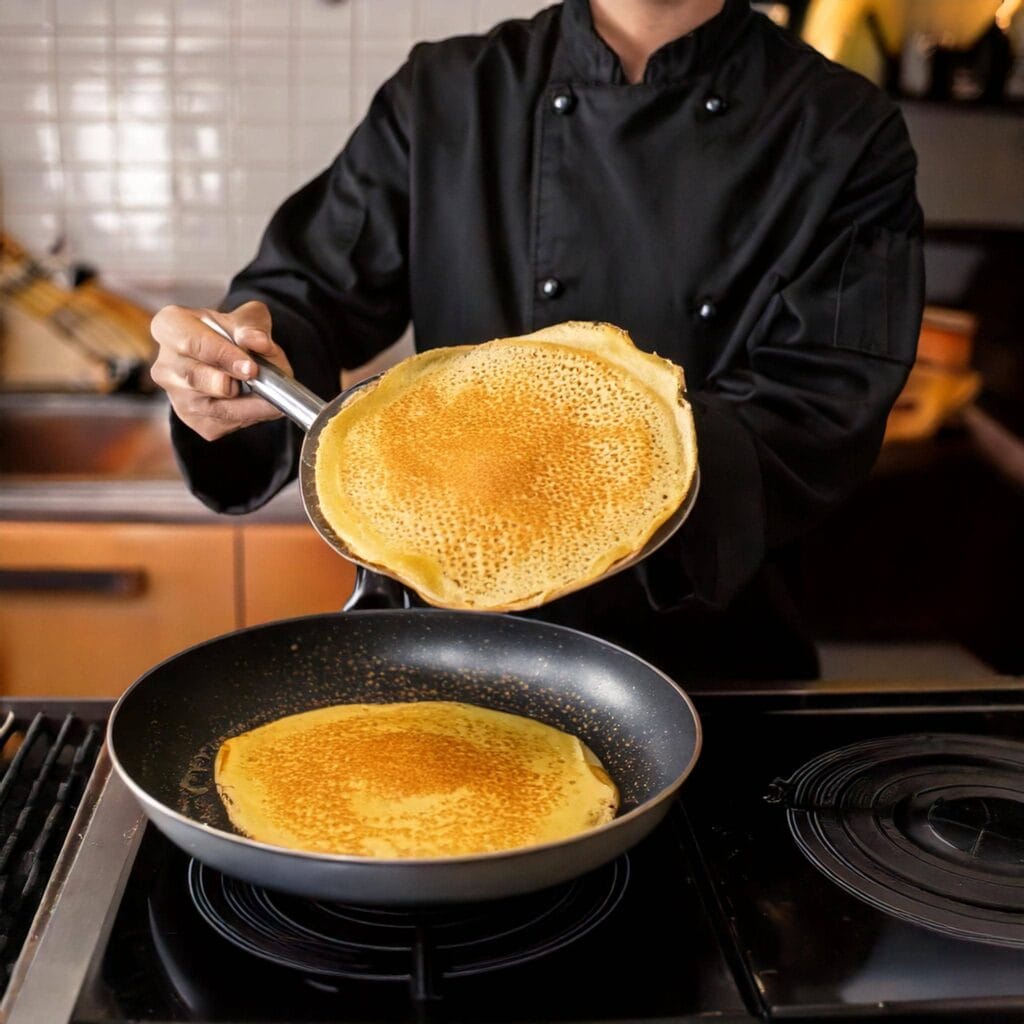
Choosing the Right Pan
The pan you use significantly affects the outcome.
- Non-stick Pan: Use a high-quality non-stick pan or a seasoned cast-iron skillet to prevent sticking.
- Correct Size: A pan with an 8- to 10-inch diameter is ideal for standard crêpes.
- Even Heating: Ensure your pan heats evenly for uniform cooking.
Preheating the Pan
A hot, evenly-heated pan is what is the secret of a good crêpe when cooking. It ensures even browning and prevents sticking.
- Medium Heat: Preheat the pan over medium heat for 3-5 minutes before cooking.
- Testing the Heat: Drop a small amount of batter into the pan. It should sizzle gently and form bubbles quickly without burning.
- Greasing the Pan: Lightly brush the pan with melted butter or oil before each crêpe. Use a paper towel to remove excess grease for a thin coating.
Pouring and Spreading the Batter
Quickly spreading the batter in the pan is what is the secret of a good crêpe for making thin, even crêpes.
- Right Amount: Use about 1/4 cup of batter for a standard crêpe. Adjust the amount depending on your pan size.
- Pour and Tilt: Pour the batter into the center of the pan, then tilt and swirl the pan in a circular motion to spread the batter evenly.
- Speed Matters: Move quickly, as the batter starts cooking as soon as it touches the hot surface.
Cooking the Crêpe
- First Side: Cook for 1-2 minutes until the edges start to lift, and the bottom is golden brown.
- Checking Doneness: Use a spatula to lift the edge and check the underside. It should be lightly browned and dry.
- Flip Gently: Slide a spatula under the crêpe, lift it slightly, and flip it in one quick motion.
Cooking the Second Side
- Shorter Cooking Time: The second side needs only 30-45 seconds, as it cooks faster.
- Golden Finish: It should have small golden spots without being too crispy.
Stacking and Keeping Warm
- Stacking Tip: Place cooked crêpes on a plate with parchment paper between each one to prevent sticking.
- Keeping Warm: Cover the stack with foil or a clean towel to retain warmth.
Common Cooking Mistakes to Avoid
- Pan Too Hot: If the pan is too hot, the crêpes will burn before cooking through. Lower the heat slightly.
- Uneven Spreading: If the batter spreads unevenly, adjust your pouring and swirling technique.
- Skipping Greasing: Never skip greasing the pan; even non-stick pans may cause sticking.
By following these cooking techniques, you’ll consistently create crêpes that are light, golden, and perfectly cooked.
Flipping and Presentation
Flipping with confidence and presenting crêpes beautifully are what is the secret of a good crêpe when serving.
How to Flip Crêpes with Ease
Using a thin spatula and flipping quickly are what is the secret of a good crêpe for achieving a flawless finish.
1. Use the Right Tools:
- A wide, flexible spatula is ideal for flipping crêpes without tearing them.
- A flat, thin-edged turner works well for lifting delicate edges.
2. Loosen the Edges First:
- Gently slide the spatula around the crêpe’s edges to loosen them from the pan.
- If the crêpe lifts easily, it’s ready to flip.
3. Flip with Confidence:
- Hold the pan handle firmly and tilt it slightly.
- Slide the spatula under the crêpe’s center, lift it slightly, and flip with a quick wrist motion.
- If you feel adventurous, try flipping the crêpe with a pan toss. Practice over a surface to avoid spills.
4. Avoid Overcooking:
- The second side cooks much faster—about 30-45 seconds—so watch carefully to avoid burning.
How to Serve Crêpes
Presentation can transform a simple crêpe into a restaurant-quality dish. Here are some serving techniques:
1. Fold or Roll the Crêpes:
- Classic Fold: Fold the crêpe in half, then fold again into a triangular shape.
- Elegant Roll: Spread your filling evenly, roll the crêpe tightly, and slice it diagonally for a gourmet look.
- Crêpe Stack (Gateau de Crêpes): Layer crêpes with fillings like cream or fruit for an impressive cake-like presentation.
2. Add Toppings Creatively:
- Dust with Powdered Sugar: A light dusting of sugar adds elegance.
- Drizzle with Sauces: Use chocolate, caramel, or fruit sauce for extra flavor.
- Sprinkle with Nuts or Fresh Fruit: Almond slices, berries, or citrus zest enhance taste and appearance.
Presentation Ideas for Special Occasions
1. Brunch Display:
- Serve a variety of crêpes on a large platter with bowls of fillings, toppings, and sauces on the side for a DIY crêpe bar.
2. Dessert Showcase:
- Create a beautiful dessert plate by stacking crêpes with layers of whipped cream, mascarpone, or Nutella. Add a mint leaf for a finishing touch.
3. Gourmet Style:
- Use a piping bag for precise filling placement and decorative sauce drizzles. Garnish with edible flowers for a refined presentation.
Common Flipping and Presentation Mistakes to Avoid
- Tearing the Crêpes: Be gentle when flipping and avoid forceful motions.
- Stacking Too Soon: Don’t stack crêpes while they’re too hot; they may stick together.
- Messy Presentation: Use clean edges, balanced fillings, and creative plating for a polished look.
With these flipping and presentation tips, your crêpes will not only taste delicious but also look stunning on the plate.
Delicious Crêpe Fillings
The beauty of crêpes lies in their versatility. They can be enjoyed as sweet desserts, savory meals, or even light snacks. Choosing the right fillings elevates crêpes from simple to spectacular. Here’s a selection of the best sweet and savory crêpe fillings for any occasion.
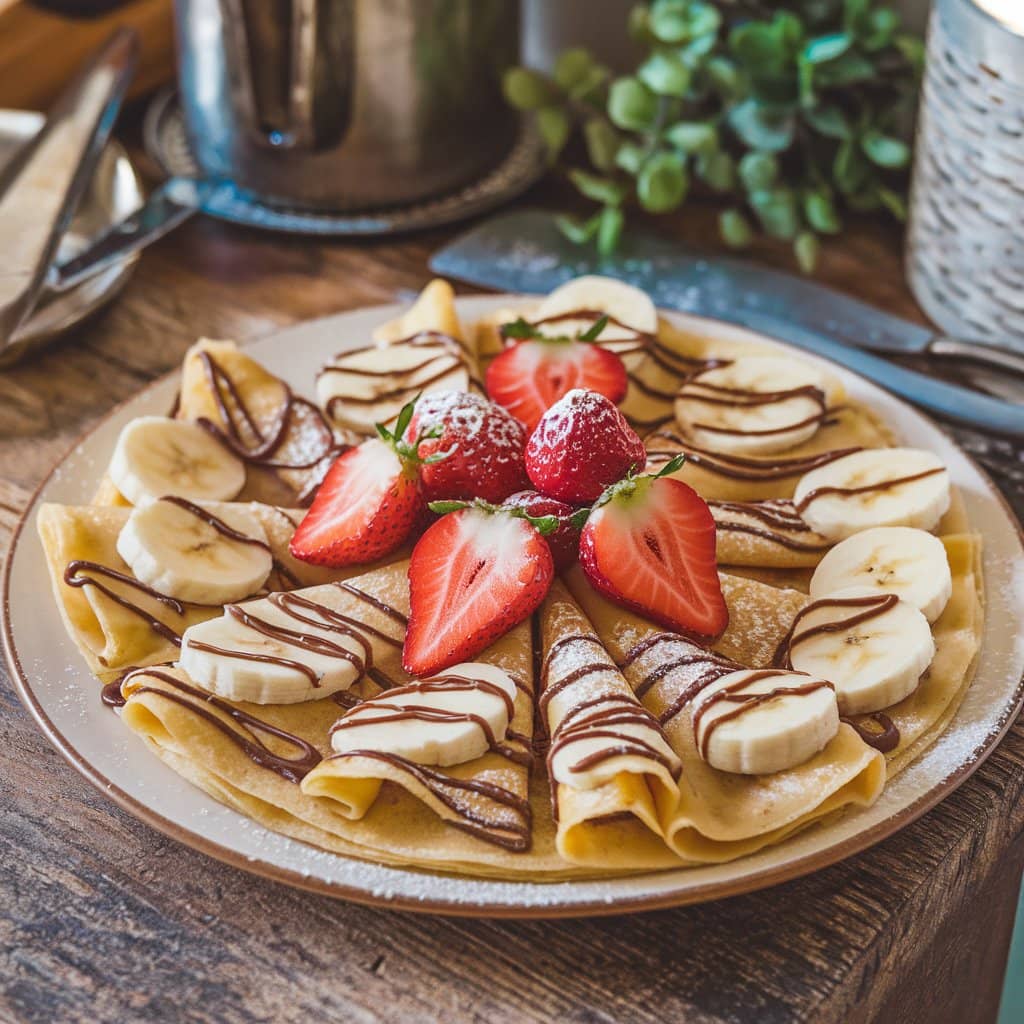
Sweet Crêpe Fillings
1. Classic Sugar and Lemon
- How to Make: Sprinkle granulated sugar over the crêpe and squeeze fresh lemon juice on top. Fold into triangles.
- Why It Works: The sweet-sour combination is refreshing and simple.
2. Nutella and Banana
- How to Make: Spread Nutella on the crêpe and add banana slices. Roll or fold.
- Why It Works: The creamy chocolate pairs perfectly with the natural sweetness of bananas.
3. Fresh Berries and Whipped Cream
- How to Make: Fill with mixed berries (strawberries, blueberries, raspberries) and top with whipped cream.
- Why It Works: The juicy berries add freshness, while the cream balances the tartness.
4. Chocolate and Strawberries
- How to Make: Spread melted chocolate and top with sliced strawberries.
- Why It Works: This is a romantic, crowd-pleasing dessert crêpe.
5. Caramel and Apples
- How to Make: Cook sliced apples with butter, sugar, and cinnamon. Fill the crêpe and drizzle with caramel sauce.
- Why It Works: The warm, spiced apples create a deliciously cozy treat.
6. Custard and Almonds
- How to Make: Spread vanilla custard inside and sprinkle with toasted almonds.
- Why It Works: This combination is rich, creamy, and texturally interesting.
Savory Crêpe Fillings
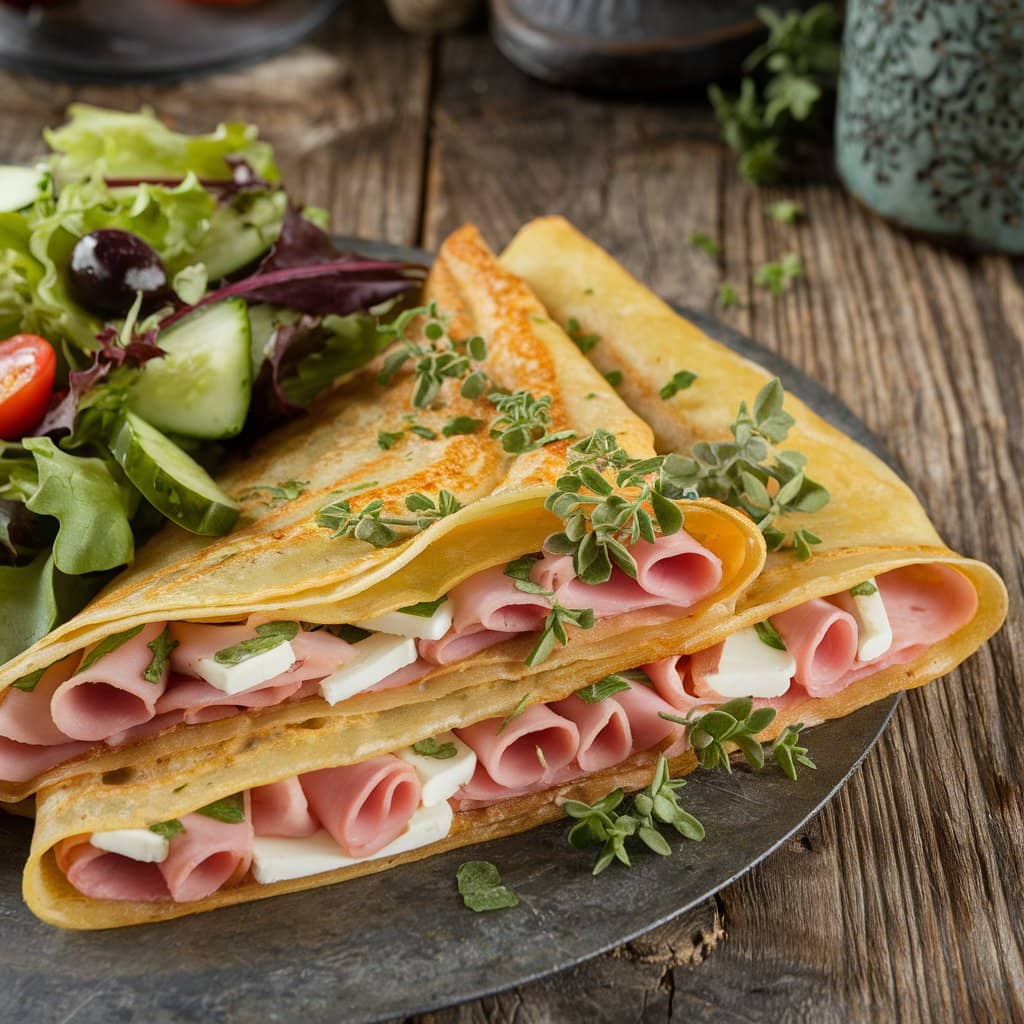
1. Ham, Cheese, and Egg (Crêpe Complète)
- How to Make: Fill the crêpe with sliced ham, grated cheese (like Gruyère), and a fried egg.
- Why It Works: This classic French crêpe is hearty and satisfying.
2. Spinach and Ricotta
- How to Make: Sauté spinach with garlic, mix with ricotta cheese, and season with nutmeg.
- Why It Works: This filling is creamy, savory, and nutritious.
3. Smoked Salmon and Cream Cheese
- How to Make: Spread cream cheese on the crêpe and add slices of smoked salmon, capers, and red onion.
- Why It Works: The smoky, creamy, and tangy flavors create a gourmet experience.
4. Chicken and Mushroom
- How to Make: Cook chicken with mushrooms, onions, and a creamy white sauce. Fill the crêpe and sprinkle with fresh herbs.
- Why It Works: It’s a comforting, flavorful filling perfect for dinner.
5. Ratatouille
- How to Make: Use a medley of sautéed vegetables like zucchini, eggplant, bell peppers, and tomatoes.
- Why It Works: This vegetarian option is healthy, filling, and packed with Mediterranean flavors.
6. Cheese and Herbs
- How to Make: Fill the crêpe with a blend of soft cheeses like goat cheese or mozzarella and fresh herbs like basil and chives.
- Why It Works: It’s a light yet flavorful choice with a fresh, aromatic touch.
Customizing Crêpe Fillings
Mix and Match Tips:
- Sweet Pairings: Try combining Nutella with berries, or caramel with pecans.
- Savory Combinations: Mix spinach with feta or add bacon to cheese-filled crêpes.
Seasonal Ideas:
- Summer: Use fresh fruits like peaches and cherries.
- Winter: Try warm fillings like spiced apples, chocolate, or creamy mushrooms.
Common Filling Mistakes to Avoid
- Overloading the Crêpe: Too much filling can cause the crêpe to tear. Use moderate amounts.
- Uneven Distribution: Spread fillings evenly for better taste and presentation.
- Using Watery Ingredients: Drain moist ingredients like tomatoes or cooked vegetables to avoid soggy crêpes.
By choosing the right fillings and balancing flavors, you can create unforgettable crêpes for any meal or celebration.
FAQs About Making Perfect Crêpes
Here are some frequently asked questions about making crêpes, along with expert tips to help you master the process.
1. Why Are My Crêpes Sticking to the Pan?
Common Causes:
- Improper Pan: Use a non-stick pan or a well-seasoned cast-iron skillet.
- Lack of Grease: Lightly grease the pan with melted butter or oil before each crêpe.
- Pan Temperature: Ensure the pan is hot but not smoking.
Solution:
Preheat the pan, lightly grease it, and let the batter set for a few seconds before spreading.
2. How Do I Avoid Lumpy Batter?
Common Causes:
- Skipping Sifting: Unsifted flour can create lumps.
- Incorrect Mixing: Adding liquid too quickly can cause clumps.
Solution:
Sift the flour before adding it. Mix slowly by adding liquid gradually while whisking continuously. Using a blender ensures a lump-free batter.
3. How Long Should I Rest the Batter?
Why Resting Is Important:
- Resting the batter allows the flour to absorb moisture, resulting in tender, elastic crêpes.
Recommended Time:
- Minimum: 30 minutes at room temperature.
- Best: 1-2 hours or overnight in the refrigerator for maximum smoothness.
4. Can I Make Crêpe Batter Ahead of Time?
Yes! Crêpe batter can be made up to 24 hours in advance. Store it in an airtight container in the refrigerator. Before cooking, whisk the batter gently to redistribute any settled ingredients.
5. Why Are My Crêpes Too Thick?
Common Causes:
- Thick Batter: Batter consistency may be too dense.
- Incorrect Pouring: Pouring too much batter into the pan leads to thick crêpes.
Solution:
Thin the batter by adding a splash of milk or water. Use a ladle or measuring cup to pour a consistent amount of batter each time. Swirl the pan quickly to spread the batter thinly.
6. How Do I Keep Crêpes Warm for a Crowd?
Best Methods:
- Stack and Cover: Stack cooked crêpes on a plate, separating each with parchment paper. Cover them with foil or a clean kitchen towel.
- Low Oven Heat: Place the crêpes in a preheated oven at 200°F (95°C) to keep them warm without drying out.
7. What Is the Best Way to Store Leftover Crêpes?
Storage Tips:
- Refrigerate: Place crêpes in an airtight container with parchment paper between them. Store in the refrigerator for up to 3 days.
- Freeze: Stack crêpes with parchment paper and place them in a freezer-safe bag. They can be frozen for up to 2 months.
Reheating:
- Microwave: Heat crêpes on a plate for 20-30 seconds.
- Stovetop: Reheat in a lightly greased pan for 30 seconds per side.
8. Can I Use a Regular Frying Pan for Crêpes?
Yes, but… While a non-stick frying pan works, a crêpe-specific pan with low edges makes flipping and spreading easier. Ensure your pan is well-greased and preheated for best results.
9. Can I Make Gluten-Free or Vegan Crêpes?
Absolutely!
For Gluten-Free Crêpes:
- Use gluten-free flour blends or buckwheat flour.
For Vegan Crêpes:
- Substitute eggs with a flaxseed mixture (1 tbsp ground flaxseed + 3 tbsp water per egg). Use plant-based milk like almond or soy and coconut oil instead of butter.
10. What Fillings Work Best for Kids?
Kid-Friendly Favorites:
- Nutella and Bananas
- Peanut Butter and Jelly
- Cheese and Ham
- Chocolate Chips and Whipped Cream
Conclusion
Making the perfect crêpe isn’t just about following a recipe—it’s about mastering the right techniques, selecting quality ingredients, and practicing patience. From choosing the ideal flour and resting the batter to flipping with confidence and exploring creative fillings, each step contributes to crêpes that are light, flavorful, and beautifully presented.
Whether you’re preparing a classic sugar-and-lemon crêpe for a quick treat or crafting a gourmet smoked salmon and cream cheese masterpiece for brunch, the secrets shared in this guide will help you create crêpes that impress every time. With practice and creativity, you can turn this traditional French delicacy into a beloved signature dish at home.
So, preheat your pan, prepare your batter, and start flipping your way to crêpe perfection!

